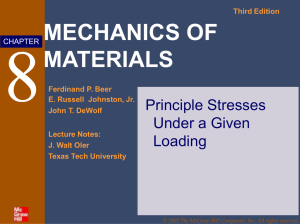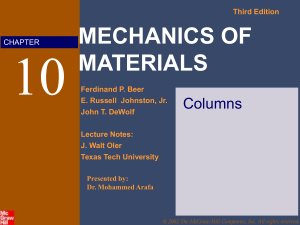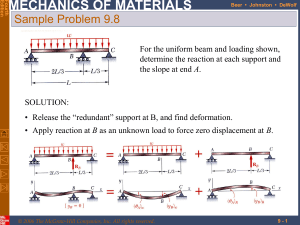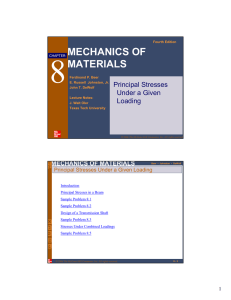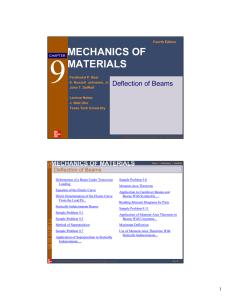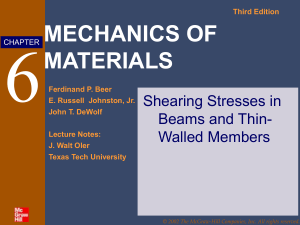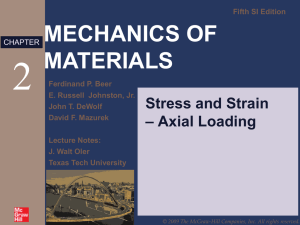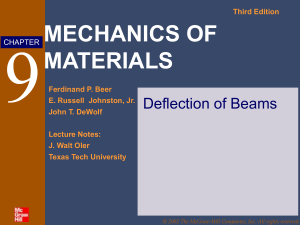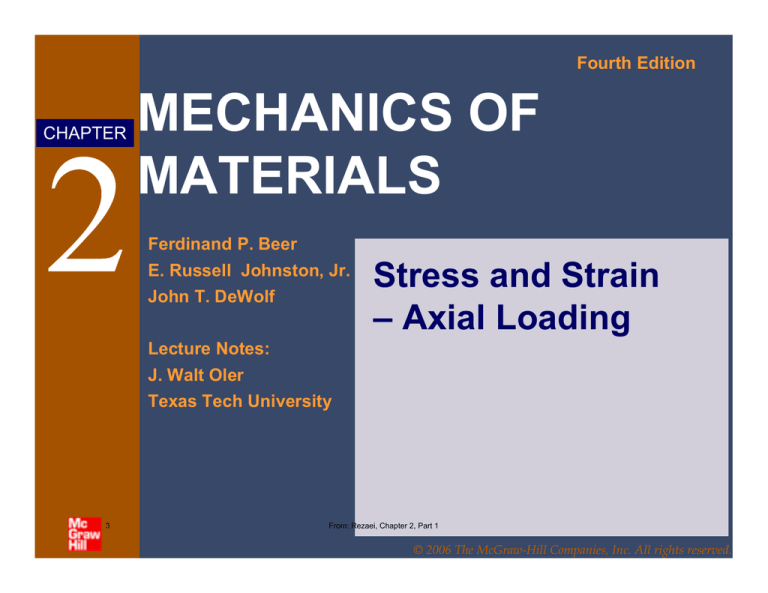
Fourth Edition
CHAPTER
MECHANICS OF
MATERIALS
Ferdinand P. Beer
E. Russell Johnston, Jr.
John T. DeWolf
Stress and Strain
– Axial Loading
Lecture Notes:
J. Walt Oler
Texas Tech University
3
From: Rezaei, Chapter 2, Part 1
© 2006 The McGraw-Hill Companies, Inc. All rights reserved.
Fourth
Edition
MECHANICS OF MATERIALS
Beer • Johnston • DeWolf
Stress & Strain: Axial Loading
• Suitability of a structure or machine may depend on the deformations in
the structure as well as the stresses induced under loading. Statics
analyses alone are not sufficient.
• Considering structures as deformable allows determination of member
forces and reactions which are statically indeterminate.
• Determination of the stress distribution within a member also requires
consideration of deformations in the member.
• Chapter 2 is concerned with deformation of a structural member under
axial loading. Later chapters will deal with torsional and pure bending
loads.
4
From: Rezaei, Chapter 2, Part 1
© 2006 The McGraw-Hill Companies, Inc. All rights reserved.
2-3
Fourth
Edition
MECHANICS OF MATERIALS
Beer • Johnston • DeWolf
Normal Strain
P
σ = = stress
A
2P P
σ=
=
2A A
ε=
ε=
5
δ
L
= normal strain
δ
L
From: Rezaei, Chapter 2, Part 1
© 2006 The McGraw-Hill Companies, Inc. All rights reserved.
P
σ=
A
2δ δ
ε=
=
2L L
2-4
Fourth
Edition
MECHANICS OF MATERIALS
Beer • Johnston • DeWolf
Stress-Strain Test
6
From: Rezaei, Chapter 2, Part 1
© 2006 The McGraw-Hill Companies, Inc. All rights reserved.
2-5
Fourth
Edition
MECHANICS OF MATERIALS
Beer • Johnston • DeWolf
Stress-Strain Diagram: Ductile Materials
7
From: Rezaei, Chapter 2, Part 1
© 2006 The McGraw-Hill Companies, Inc. All rights reserved.
2-6
Fourth
Edition
MECHANICS OF MATERIALS
Beer • Johnston • DeWolf
Stress-Strain Diagram: Brittle Materials
8
From: Rezaei, Chapter 2, Part 1
© 2006 The McGraw-Hill Companies, Inc. All rights reserved.
2-7
Fourth
Edition
MECHANICS OF MATERIALS
Beer • Johnston • DeWolf
Hooke’s Law: Modulus of Elasticity
• Below the yield stress
σ = Eε
E = Youngs Modulus or
Modulus of Elasticity
• Strength is affected by alloying,
heat treating, and manufacturing
process but stiffness (Modulus of
Elasticity) is not.
9
From: Rezaei, Chapter 2, Part 1
© 2006 The McGraw-Hill Companies, Inc. All rights reserved.
2-8
Fourth
Edition
MECHANICS OF MATERIALS
Beer • Johnston • DeWolf
Elastic vs. Plastic Behavior
• If the strain disappears when the
stress is removed, the material is
said to behave elastically.
• The largest stress for which this
occurs is called the elastic limit.
• When the strain does not return
to zero after the stress is
removed, the material is said to
behave plastically.
10
From: Rezaei, Chapter 2, Part 1
© 2006 The McGraw-Hill Companies, Inc. All rights reserved.
2-9
Fourth
Edition
MECHANICS OF MATERIALS
Beer • Johnston • DeWolf
Deformations Under Axial Loading
• From Hooke’s Law:
σ = Eε
ε=
σ
E
=
P
AE
• From the definition of strain:
ε=
δ
L
• Equating and solving for the deformation,
PL
δ =
AE
• With variations in loading, cross-section or
material properties,
PL
δ =∑ i i
i Ai Ei
11
From: Rezaei, Chapter 2, Part 1
© 2006 The McGraw-Hill Companies, Inc. All rights reserved.
2 - 11
Fourth
Edition
MECHANICS OF MATERIALS
Beer • Johnston • DeWolf
Example 2.01
SOLUTION:
• Divide the rod into components at
the load application points.
E = 29 ×10
−6
• Apply a free-body analysis on each
component to determine the
internal force
psi
D = 1.07 in. d = 0.618 in.
• Evaluate the total of the component
deflections.
Determine the deformation of
the steel rod shown under the
given loads.
12
From: Rezaei, Chapter 2, Part 1
© 2006 The McGraw-Hill Companies, Inc. All rights reserved.
2 - 12
Fourth
Edition
MECHANICS OF MATERIALS
SOLUTION:
• Divide the rod into three
components:
Beer • Johnston • DeWolf
• Apply free-body analysis to each
component to determine internal forces,
P1 = 60 × 103 lb
P2 = −15 × 103 lb
P3 = 30 × 103 lb
• Evaluate total deflection,
Pi Li 1 ⎛ P1L1 P2 L2 P3 L3 ⎞
⎟⎟
= ⎜⎜
+
+
A
E
E
A
A
A
i i i
⎝ 1
2
3 ⎠
δ =∑
(
) (
) (
)
⎡ 60 × 103 12 − 15 × 103 12 30 × 103 16 ⎤
=
+
+
⎥
6⎢
0.9
0.9
0.3
29 × 10 ⎣⎢
⎦⎥
1
= 75.9 × 10−3 in.
L1 = L2 = 12 in.
L3 = 16 in.
A1 = A2 = 0.9 in 2
A3 = 0.3 in 2
13
δ = 75.9 × 10−3 in.
From: Rezaei, Chapter 2, Part 1
© 2006 The McGraw-Hill Companies, Inc. All rights reserved.
2 - 13
Fourth
Edition
MECHANICS OF MATERIALS
Beer • Johnston • DeWolf
Sample Problem 2.1
SOLUTION:
The rigid bar BDE is supported by two
links AB and CD.
• Apply a free-body analysis to the bar
BDE to find the forces exerted by
links AB and DC.
• Evaluate the deformation of links AB
and DC or the displacements of B
and D.
• Work out the geometry to find the
Link AB is made of aluminum (E = 70
deflection at E given the deflections
GPa) and has a cross-sectional area of 500
at B and D.
mm2. Link CD is made of steel (E = 200
GPa) and has a cross-sectional area of (600
mm2).
For the 30-kN force shown, determine the
deflection a) of B, b) of D, and c) of E.
14
From: Rezaei, Chapter 2, Part 1
© 2006 The McGraw-Hill Companies, Inc. All rights reserved.
2 - 14
Fourth
Edition
MECHANICS OF MATERIALS
Beer • Johnston • DeWolf
Sample Problem 2.1
Displacement of B:
SOLUTION:
δB =
Free body: Bar BDE
PL
AE
(
− 60 × 103 N )(0.3 m )
=
(500 ×10-6 m2 )(70 ×109 Pa )
= −514 × 10 − 6 m
δ B = 0.514 mm ↑
∑MB = 0
0 = −(30 kN × 0.6 m ) + FCD × 0.2 m
Displacement of D:
FCD = +90 kN tension
δD =
PL
AE
0 = −(30 kN × 0.4 m ) − FAB × 0.2 m
(
90 ×103 N )(0.4 m )
=
(600 ×10-6 m2 )(200 ×109 Pa )
FAB = −60 kN compression
= 300 × 10− 6 m
∑ MD = 0
15
From: Rezaei, Chapter 2, Part 1
© 2006 The McGraw-Hill Companies, Inc. All rights reserved.
δ D = 0.300 mm ↓
2 - 15
Fourth
Edition
MECHANICS OF MATERIALS
Beer • Johnston • DeWolf
Sample Problem 2.1
Displacement of D:
BB′ BH
=
DD′ HD
0.514 mm (200 mm ) − x
=
0.300 mm
x
x = 73.7 mm
EE ′ HE
=
DD′ HD
δE
0.300 mm
=
(400 + 73.7 )mm
73.7 mm
δ E = 1.928 mm
δ E = 1.928 mm ↓
16
From: Rezaei, Chapter 2, Part 1
© 2006 The McGraw-Hill Companies, Inc. All rights reserved.
2 - 16

